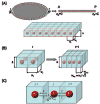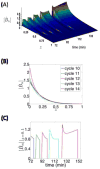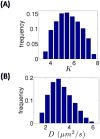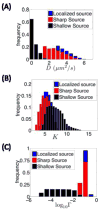A compartmental model for the bicoid gradient
- PMID: 20580703
- PMCID: PMC2919596
- DOI: 10.1016/j.ydbio.2010.05.491
A compartmental model for the bicoid gradient
Abstract
The anterior region of the Drosophila embryo is patterned by the concentration gradient of the homeodomain transcription factor bicoid (Bcd). The Bcd gradient was the first identified morphogen gradient and continues to be a subject of intense research at multiple levels, from the mechanisms of RNA localization in the oocyte to the evolution of the Bcd-mediated patterning events in multiple Drosophila species. Critical assessment of the mechanisms of the Bcd gradient formation requires biophysical models of the syncytial embryo. Most of the proposed models rely on reaction-diffusion equations, but their formulation and applicability at high nuclear densities is a nontrivial task. We propose a straightforward alternative in which the syncytial blastoderm is approximated by a periodic arrangement of well-mixed compartments: a single nucleus and an associated cytoplasmic region. We formulate a compartmental model, constrain its parameters by experimental data, and demonstrate that it provides an adequate description of the Bcd gradient dynamics.
Copyright 2010 Elsevier Inc. All rights reserved.
Figures




Similar articles
-
A precise Bicoid gradient is nonessential during cycles 11-13 for precise patterning in the Drosophila blastoderm.PLoS One. 2008;3(11):e3651. doi: 10.1371/journal.pone.0003651. Epub 2008 Nov 7. PLoS One. 2008. PMID: 18989373 Free PMC article.
-
mRNA diffusion explains protein gradients in Drosophila early development.J Theor Biol. 2010 Jun 7;264(3):847-53. doi: 10.1016/j.jtbi.2010.03.012. Epub 2010 Mar 15. J Theor Biol. 2010. PMID: 20230838
-
Probing intrinsic properties of a robust morphogen gradient in Drosophila.Dev Cell. 2008 Oct;15(4):558-67. doi: 10.1016/j.devcel.2008.09.004. Dev Cell. 2008. PMID: 18854140 Free PMC article.
-
Seeing is believing: the bicoid morphogen gradient matures.Cell. 2004 Jan 23;116(2):143-52. doi: 10.1016/s0092-8674(04)00037-6. Cell. 2004. PMID: 14744427 Review.
-
A matter of time: Formation and interpretation of the Bicoid morphogen gradient.Curr Top Dev Biol. 2020;137:79-117. doi: 10.1016/bs.ctdb.2019.11.016. Epub 2019 Dec 27. Curr Top Dev Biol. 2020. PMID: 32143754 Review.
Cited by
-
Bicoid gradient formation mechanism and dynamics revealed by protein lifetime analysis.Mol Syst Biol. 2018 Sep 4;14(9):e8355. doi: 10.15252/msb.20188355. Mol Syst Biol. 2018. PMID: 30181144 Free PMC article.
-
Two-Exponential Models of Gene Expression Patterns for Noisy Experimental Data.J Comput Biol. 2018 Nov;25(11):1220-1230. doi: 10.1089/cmb.2017.0063. Epub 2018 Aug 17. J Comput Biol. 2018. PMID: 30117746 Free PMC article.
-
Torso RTK controls Capicua degradation by changing its subcellular localization.Development. 2012 Nov;139(21):3962-8. doi: 10.1242/dev.084327. Development. 2012. PMID: 23048183 Free PMC article.
-
Self-Similar Dynamics of Nuclear Packing in the Early Drosophila Embryo.Biophys J. 2019 Aug 20;117(4):743-750. doi: 10.1016/j.bpj.2019.07.009. Epub 2019 Jul 16. Biophys J. 2019. PMID: 31378311 Free PMC article.
-
Pseudocleavage furrows restrict plasma membrane-associated PH domain in syncytial Drosophila embryos.Biophys J. 2022 Jun 21;121(12):2419-2435. doi: 10.1016/j.bpj.2022.05.015. Epub 2022 May 18. Biophys J. 2022. PMID: 35591789 Free PMC article.
References
-
- Aegerter-Wilmsen T, Aegerter CM, Bisseling T. Model for the robust establishment of precise proportions in the early Drosophila embryo. Journal of Theoretical Biology. 2005;234:13–19. - PubMed
-
- Crauk O, Dostatni N. Bicoid determines sharp and precise target gene expression in the Drosophila embryo. Curr Biol. 2005;15:1888–1898. - PubMed
-
- DeLotto R, DeLotto Y, Steward R, Lippincott-Schwartz J. Nucleocytoplasmic shuttling mediates the dynamic maintenance of nuclear Dorsal levels during Drosophila embryogenesis. Development. 2007;134:4233–4241. - PubMed
MeSH terms
Substances
Grants and funding
LinkOut - more resources
Full Text Sources
Molecular Biology Databases

